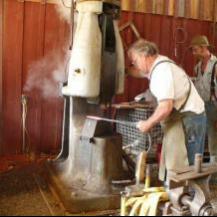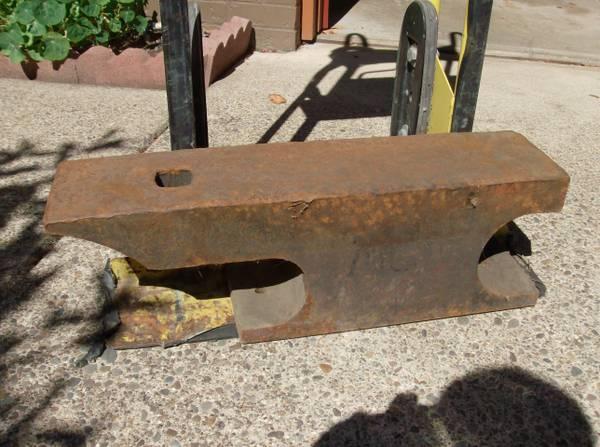-
Posts
48 -
Joined
-
Last visited
Content Type
Profiles
Forums
Articles
Gallery
Downloads
Events
Posts posted by Coalforge
-
-
Had to pull broken studs out of a model A engine.
-
You work it until just before you ruin it, then you stop.
-
I acquired the H frame press in a trade. Whoever built it used 1/4 by 8" channel iron and bolted it together. I got it primarily for the components and knew it would not stay in the form I received it. I have heavy I beam to make a press but I was wondering what people were using for a general shop press. I have used it to form drop handles and to hot form 1/4" plate into candle holders. I want to build a solid press before I try much more with it. I am not a knifemaker but I can see using a press with pattern dies occasionally.
-
What size cylinders and what pressures are you folks that have a hydraulic press running? I currently have a H frame that runs a 5" cylinder at 2000 psi. The frame flexes at full pressure. I am looking at building a narrow throat C frame press and trying to figure out if I am better off using the cylinder and power supply I have or looking for something different. Thanks
-
-
Where was the video shot?
-
This is in the Deception Pass Park. I made 4 handles, roof truss braces and some other ironwork for he Cranberry Lake area on Whidbey Island in 2003 for some restoration work for the CCC's 70th anniversary. The handles I am making now are copies of a forged handle on the bath house on Fidalgo Island, north of the bridge
-
I notice that one table is common pipe fittings and pipe legs, another table is 4x4 legs, and only one table looks like it is an institutional welded table. I was of the understanding that local materials and local craftspersons provided as much as possible, if it wasn't made by members of the corps (I could be wrong). It is entirely likely that the hardware at one location is completely different from hardware used at another location. This means that matching the hardware at the location it is being used is what matters. Can you get a tour of where the hardware is being used? Or at least a detailed photographic tour so as to match what is there? Phil
There were craftsmen that taught various crafts to the enrollees. (see the note above from tomhw) While the buildings that housed the members were often simple, some of the work done on the structures done for State and National Parks shows some fine work and artistry. I have photos of the building where the handles will go as well as handles on the exterior doors that I am duplicating from a nearby building. As soon as I can post photos, I will. There are no cabnets in any of the buildings and the outside doors have a large double scroll that wouldn't work on cabinets. If I had something to copy, I would do it but with nothing existing at present, I am after ideas from other CCC sites. Several years ago I made handles in another area of the same park (several miles and a ferry ride away and in a different county) Those are totally different than where I am working now. The CCC was building the bridge to replace the ferry. See http://en.wikipedia....ion_Pass_Bridge
1 - This is the building that will get the handles
2 - handles I am duplicating for the outside doors
3 - inside of handle 2
4 - Handles I made several years ago in a different area of the same park
I originally wanted to put thumbnails under my first post but couldn't make it work. Is there any way I can edit my first post either to include the thumbnails or so I can refer people to the photos? -
Thanks for all the replies. It is starting to look like the individual camps had a fair amount of leeway in what they did. Apparently I can't add photos here so I will try something else.
-
I had an inquiry from a local State Park wanting handles for cabinets in an old C.C.C. building that is being converted to a classroom. I have not been able to find any examples of cabinet handles that might have been used in C.C.C. buildings. I am looking for suggestions or examples. Thanks
See photos at post # 19 this thread -
One thing I have not seen mentioned here is oil the clutch! I use bar oil except for the clutch where I use 20wt. I find with bar oil, the clutch will hang up some.
-
Hello Scott. I am not familiar with the "smithy special" anvil. I used and sold TFS anvils for a number of years. TFS (Texas Farrier Supply) makes both London pattern and double horn anvils in a variety of sizes. I was quite happy with them and I quit being a dealer due to business conditions on my end. I have one and could refer you to several owners around the northwest who use them. Daryl Nelson bought several that he uses in his school in Eatonville, WA. I feel they are a good anvil and at the time, were reasonably priced. I have been out of the retail business for several years and I don't know how prices are now.
-
A sign in a shop i was in had a sign on the power hammer that said "THIS MACHINE HAS NO BRAIN - USE YOUR OWN!" You expressed this very well.
-
I use only use coke and don't have a problem. A couple hints for the welding though. Your piece should be about the middle depth of the fire. If you go too far down, you are in the airflow and too high, there is not enough heat above your work. Heat the piece fairly slowly so it is hot all the way through, not just on the surface. The piece should be the same color as the surrounding fire. If it is darker than the fire, your temperature is wrong. When you hammer the weld, it does NOT take a hard blow. I saw a demo once where the smith made the weld using only a hammer handle (no head on the handle) Get the weld started, then back in the fire. Finish it on a following heat.
Heavier metal actually welds easier than small stock as it doesn't loose heat so fast. For small stock, I have a section of railroad track that I set in the forge so I can be quick getting those first hits.
Hope this is of some help. -
Quote: Well, I am kind of out of enough wall space. I added a couple of photos further down this thread. Perhaps I should have said "Spring Dies". As to why so many, as an example there are tenon dies for 1/8, 1/4, 3/8, 1/2, 5/8, 3/4, 7/8, 1, 1 1/4 and 1 1/2. That's 10 and only discussing tenons. There are about half a dozen for different sizes of rope, texturing dies in many patterns for both flat and for round stock, ones to make different sizes of ball ends, etc. It doesn't take long for them to add up.
Dang, Coalforge. You must do some serious smithing!!! I only have a few spring swages and that keeps me confused.
I only have a few spring swages and that keeps me confused. 
I did mostly agricultural smithing until the last dairy closed here on the island. When I started there were 14 dairys. Now we are a National Historic Preserve. (http://www.nps.gov/ebla/index.htm) and I am doing more ornamental work. A lot of repair on old house jewelry and gates and such. -
Four inches wide? I'm not quite following your geometry there. My spring tools are mostly less than 1-1/2" thick the way they would hang on bar.
I'm not quite following your geometry there. My spring tools are mostly less than 1-1/2" thick the way they would hang on bar.
I agree that I don't like hanging them over a bar. You can't see the business end and they don't lift off easily. I have a wall with some nails in it near the hammer. Swages on one nail; fullers on another and so forth. I may have to move one or two to get the one underneath but I try to plan my processes so I'm not looking for a tool with a hot piece of steel in my hand either.
Thanks for the reply. I added a couple photos on this thread of what I am planning to do. Perhaps I should have used the terms "Swedge" or "Die" rather than fuller. I am not looking for them with hot metal in my hand but I had them either in a metal box or on the floor by one of the hammers. I was just looking for a better system and interested in what other people were doing. -
Uhhh-Anything wrong with nails on the wall? Up and down the wall they shouldn't take up that much space. What in the world do you DO with 40 spring fullers?
Well, I am kind of out of enough wall space. I added a couple of photos further down this thread. Perhaps I should have said "Spring Dies". As to why so many, as an example there are tenon dies for 1/8, 1/4, 3/8, 1/2, 5/8, 3/4, 7/8, 1, 1 1/4 and 1 1/2. That's 10 and only discussing tenons. There are about half a dozen for different sizes of rope, texturing dies in many patterns for both flat and for round stock, ones to make different sizes of ball ends, etc. It doesn't take long for them to add up. -
-
Spring fullers are easy. Just hang them over a rod.
40 fullers at an average of 4 inches wide will take over 13 feet of rod and I need to see what they are. -
I need to get a system to hold about 40 spring fullers so I can see what they are. I have some ideas but was wondering what anyone else is doing.
-
Somewhere on here, there was an address to download a couple of the English "Rural Development Commission" books. I was looking for The 'Catalogue of Drawings for Wrought Ironwork", and the "Catalogue of Drawings - Wrought Ironwork Gates". If anyone knows the site address or where the books might be available, please let me know.
Thanks
Wayne (Coalforge) -
We are all well and no serious damage. Next winter's firewood is already down, I just need to cut it up.
-
We are pulling for you both, Ralph. While I have not had it, I have lived with it enough to know how it goes. You both are in our prayers. Give Dawn a hug for us.
Wayne -
First off, thank you all for your prayers and support. It is really wonderful. Karen started chemo again last Wednsday and Friday she had the operation to put in a line to the cardiac vein for the rest of the treatments. The operation went well and if this last week is any indication of how the chemo is going to go, life will be good. She gets tired but no nausia or cramps or anything. Thanks again for the support.
Wayne









Barbour Stockwell Beaudry 150
in Power Hammers, Treadle Hammers, Olivers
Posted
150 lb Beaudry by Barbour Stockwell (who bought Beaudry during the depression)